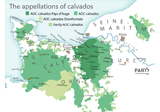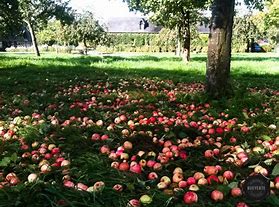The Different Tastes of Calvados
 In many ways calvados is the newest brandy of France. It only became recognised as such in 1942 when the appellation controleé regulations officially gave calvados a protected name. The area around the Valley d’Auge and the land extending east past Lisieux became the principle production area. Here, the Jurassic limestone soil is ideal for growing the various apples required to make calvados.
In many ways calvados is the newest brandy of France. It only became recognised as such in 1942 when the appellation controleé regulations officially gave calvados a protected name. The area around the Valley d’Auge and the land extending east past Lisieux became the principle production area. Here, the Jurassic limestone soil is ideal for growing the various apples required to make calvados.
A range of different apples are used initially to create the finest cider – bitter, bitter sweet, acidic and sweet. These apples have low levels of acidity so a small, firm, Perry pear is also added. This addition, usually 12 – 15 % of the total, is essential as it increases the acidity of the cider to the level required for distillation. Consequently, calvados can often have a pear drop taste which many people dislike.
Of course, the flavour of calvados from each distiller will differ. The distillation techniques, apple varieties, condition of apples when harvested and ageing process will all have an effect. Sometimes a finish is also added. This term describes a process where, in the latter stages of ageing, calvados is stored for a limited period in a barrel that has previously held another spirit or wine. However, many producers find this technique abhorrent as it masks the true identity of their spirit.
The pear drop aroma and taste is most noticeable in young calvados. With long barrel ageing it is significantly reduced because the calvados builds a richness which masks the pungency of the Perry pear. One of the best examples of this is the 1969 vintage by Dupont, a firm that has worked hard to nurture quality in their fine spirits.
 The firm of Chateau du Breuil has developed a different method of masking the pear drop effect. They only harvest naturally fallen apples which have started to go brown. At this stage the water content of the apple has dropped and the sugar content is at its highest. These apples produce a sweeter cider and ultimately a sweeter calvados with baked apple aromas and flavours. The period required to age in the barrel for the flavours to mature is therefore reduced. A fine example of this type of calvados is the Chateau du Breuil 15 Year Old.
The firm of Chateau du Breuil has developed a different method of masking the pear drop effect. They only harvest naturally fallen apples which have started to go brown. At this stage the water content of the apple has dropped and the sugar content is at its highest. These apples produce a sweeter cider and ultimately a sweeter calvados with baked apple aromas and flavours. The period required to age in the barrel for the flavours to mature is therefore reduced. A fine example of this type of calvados is the Chateau du Breuil 15 Year Old.
